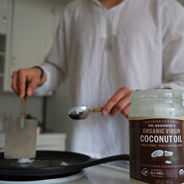Sweet Fat: A Clean Keto Blueprint
- Christian Van Camp

- Feb 10, 2020
- 14 min read
Updated: Oct 24, 2020

When something becomes mainstream in this day and age, the potential trendy benefits tend to shadow over any of the dirty drawbacks.
Most of the time, we humans blow the good news out of proportion, and whether its health or technology related, many claims seem to lack the unbiased truth and cold-hard facts—the efficacious science.
This is why I decided to finally attempt the most widely-praised diet in the 21st century: the ketogenic diet.
I needed to build my own personal conception of this fat-filled craze—without just taking that fat-lovin' YouTuber‘s word for it. So, on January 2nd, 2020, I began my first full day of keto.
I tracked everything I shoved down my chomper on MyFitnessPal for 34 days straight. Although tracking food seems like another thing to worry about in our crazy lives, it actually helped me initiate balance.
I highly recommend this tactic to anyone wanting to see their exact diet composition. This simple tally of nutrition helps you grasp an idea of what makes you feel like a heavy dump truck, or perhaps a floaty cloud.
On February 4th I relished my first carby meal after a hefty, blood-pumpin' ‘push-day’ followed by a sweaty sauna session. It also happened to be one of the worst foods to sabotage my month-long fat flow—a spoonful of raw cookie dough.
Gabe Masi (my roommate/soul brother) whipped-up this delicacy with his girlfriend Katherine as I stumbled in the kitchen shirtless and red as a ripe tomato— I popped 500mg of niacin prior to the sauna for enhanced metabolism and heat-shock protein stimulation.
It was her last night visiting Fayetteville from St. Louis, so trust me, I'm not givin’ them crap for making that chocolate chip ocean of goodness.
I savored a massive smooth spoonful. A slow-moving endorphin rush trinkled down my spine. I survived 5 weeks without any significant glucose spikes. My body (and mind) told me it was sugar refeed time.
Considering I ate this directly after an explosive workout, the sugar was sucked into my worn-down and depleted muscles.
“This is crack, guys. Keep it away from me or I’ll plow through that whole bowl...”
To be brutally honest: It was worth every second.
*I do advise against breaking your hard-earned ketogenic streak by stimulating all those crack-head brain receptors with a little scoop of white powder.
Ease into that glucose spike through fiber-rich foods like a light apple or a bowl of soaked and sprouted quinoa. This way you don’t crave that dopamine rush to the extreme and regretfully bash a whole batch of fresh baked, homemade cookies.
Yeah yeah, it sucks when that lizard-brain takes the control of the wheel. I don’t know about you, but I basically go on auto-pilot sucking up anything and everything in the fridge and pantry.
Okay, so now back to Keto...
How can keto improve (or decline) my bio-individual health?
What are the best (& tastiest) keto cuisines for fat loss, cognition, and performance?
How will keto change my biomarkers, such as cholesterol, blood sugar, and triglycerides?
Well, to start off in a simple fashion (as all things in the nutrition realm should be) the keto diet is depriving the body from a significant source of carbohydrates for an extended timeframe (i.e. <50g carbs per day for a minimum of 2 weeks).
This limits your chomper to savory fats and hearty proteins. Fats do not cause a blood sugar response, yet protein, on the other hand, will surge blood glucose if eaten in excess beyond your body’s needs via gluconeogenesis: an innate mechanism that converts extra amino acids into glucose.
For example, if you're a muscle maniac training 4+ times a week, heavy weights and all, it's typically hard to overdo protein in your diet. Your temple needs quite a bit to recover that torn tissue.
But if you're a 50 year old mostly sedentary man or woman jogging only 2x a week, you may want to be cognizant of how much protein you’re chowing down on. For instance, try to avoid eating over .8-1g protein per pound of body weight everyday on keto.
Another point be clear on: the keto diet is NOT a low carb diet. It has other important specialties we’ll plunge into.
Now why would anyone want to follow such a wild diet?
When you restrict carbs to typically 50 grams/day in most individuals, in roughly a week or 2 your body begins to elevate ketone bodies in the bloodstream and throughout the body. These ketones are produced by the liver and act as an energy source when glucose is not available. They are extremely powerful for fat loss, cognition, and mitochondrial energy. They’re an alternative fuel for our mind and body.
“Ketosis“ also kicks into gear when we fast for longer bouts of time (usually 48-72 hours ketones have a significant jump). That’s why many people worship an intermittent fasting routine stacked with keto. Even though IF is typically 12-18 hours daily, this lower adjustment still allows an amplification in fat loss, decreased cravings, boosted brain function, and makes one feel limitless. You practically are resetting your body, mind, and spirit.
Unfortunately, most Americans don't ever tap into this desirable, ancestral state. We’re prone to surge our blood sugar throughout the day, everyday—from ultra-processed fast foods and gas-station snacks.
We need to wake up and ignore Wendy and Little Debbie’s manipulative calls to buy their toxic food-like products (see what I did there).
Since I began my first full day of the keto diet on January 2nd, 2020, I have been bombarded with questions like, “why the hell are you doing such a restrictive diet, Christian?”
My overarching goal and intention to start this diet craze isn't like most people. A great deal of individuals decide to do keto for the fat loss benefits, because as I alluded to earlier, a boost in ketones causes a boost in fatty acid mobilization (aka you burn through that annoying belly fat more efficiently).
I’m already as lean as it is (under 10% body fat), so obviously I wouldn’t do the keto diet for fat loss. To be honest, I simply love to spice life's routines up, especially my diet. I thrive on self-experimentation.
Whether it’s trying new supplements, exercises, sleep routines, biohacks, or diets, human-guinea-pigging has always been a part of my motto. I love to see how my physiology reacts and responds to wild and new protocols, mainstream or not.
So that's my answer: I want to see how my cognition responds to this long-term fat-filled venture, along with my body composition, physique, and overall energy and drive.
Who knows, maybe I’ll begin to utilize the benefits of ketosis for the rest of my life.
From countless hours of research, podcasts, and readings, I discovered a uniquely “sticking” approach, mainly through Bulletproof. It’s a far healthier alternative to enacting strict ketosis daily, for months to years on end.
What makes cyclical keto stand out in the crowd versus chronic ketosis?
A cyclical ketogenic diet involves adhering to a standard keto diet 5–6 days per week, followed by 1–2 days of some carbohydrate intake. This allows your body to still come in contact with carbohydrates from preferrable sources like potatoes, soaked and sprouted ancient grains, legumes and lentils, fruit, starchier veggies, and other fiber-rich carbs.
Another cyclical approach—my man Ben Greenfield follows daily—is way, way easier to maintain than the latter. It’s basically tapping into ketosis all day long until dinnertime, eating nothing but fats and protein, then feasting on 100-200g carbohydrates in the evening. This allows your body to slightly elevate ketones until this carb-rich evening meal, therefore boosting fat-loss, cognition, and energy without the unwanted cravings.
Another reason I linger towards this daily carb-loading near nighttime is because carbohydrates boost serotonin. Elevated levels of this hormone will improve deep, restful, rejuvenating sleep. This will help you finally catch those zzz’s much easier with no problemo.
See, if you were to deprive your body of carbs for an awfully long time (i.e. years) you may manifest vitamin and mineral deficiencies, increase your disease risk (if you’re genetically incompatible with keto), and can cause undesirable metabolic shifts.
When you consume only fats and proteins for a long enough time, your badass temple becomes fat-adapted, or happy to use fats as a main source of energy (not glucose or carbs). From this procedure you develop mitochondrial machinery.
Inside your cells you have roughly 1000-2000 mitochondria, which are known as the “power plants” in high school biology. These organelles manufacture energy, known as ATP, from the food you consume, or energy from the fat on your body.
When you do long-term keto, these mitochondria become very efficient at using fats for fuel. For instance, if you were to hop outta ketosis by eating a medium-sized sweet potato, your body can actually hop right back on that ketosis train shortly after the 25g of carbs are used up. That’s less than 24 hours!
So how long do I have to be in ketosis until I can achieve this epic physiological mechanism?
Studies have shown that you can reveal this fat-adaptation response, when your cells use purely fats for ammunition, in as little as 6 weeks.
By 6-8 weeks of ketosis, your body becomes incredibly efficient at using ketones for some energy, fats for some energy, and glucose for the remaining. This is harmony.
Your body can now run on many different sources of fuel. It’s like pumping your car up with jet fuel, diesel, and gasoline… yet it operates beyond the average Joe. It’s operating on full throttle, yo.
This goes to show that carbs are not bad on the keto diet. They can be quite beneficial with that cyclical keto approach discussed earlier. By carb-loading maybe once per week or every night (after a minimum of 6-8 weeks) you are able to burn fat, gain muscle, and have an unbelievable amount of energy.
Now the real question is, how do I prepare for Keto?
For starters, make sure you’re living in an environment where you can have total control of your diet. I recommend having all the healthy ketogenic foods and cooking supplies ready to go before you even begin to dive into day one.
In order to abolish any carb cravings, gradually decrease your regular consumption of carbs for a week until you begin this full-out fat regimen. Also, be conscious about any travels, weekend parties, or any unique things in your schedule that might mess up your carb-free goal for the next month or so.
I am not saying you have to have a ridiculous amount of planning to adhere to a keto diet. You can still go out to eat with friends, travel around, or do whatever comes to mind. The keto lifestyle is totally attainable and easy-going without those crazy life restrictions you hear people talking about all the time.
As you attempt to dive into ketosis for the first couple of days, your body is going to be like, “What are ya doing here dude (or dudette)!? You haven't eaten a single carb in days! I’m revolting… you’re now going to feel a little run down and brain foggy. Oh, and I’ll throw in those relentless cravings for a bowl of sugar. Keep it up... we’ll see who wins.”
Eventually—you do win. This hellish encounter with your inner demons is completely normal. You’re encouraging your body to slowly use ketones, not glucose, for homeostasis. Balance and equilibrium takes time. It's a process.
During this first week, you’re bombarding your body with plenty of healthy fats and steering clear of any blood sugar spikes. I assume you most likely have never physiologically experienced this before.
Once you climb over this short-lasting mountain (i.e. one measly week) I guarantee you will begin to have a more vibrant complexion, less dental appointments, a sharper jawline, and the energy to chug through any task at hand.
Okay, now that I got through all the sciency things on keto and what to anticipate, what’s it truly entail… What can I eat?
Well, to kickstart a healthy and well-paced ketogenic diet, I recommend putting off any sort of inflammatory foods at bay for the first couple of weeks. Why?
It’s best to reduce as much inflammation as possible so ketones can do their job better. Any inflammatory response inhibits proper ketone formation by the liver, will boost cravings, and simply make you feel down in the dumps. Your adherence to keto will be thrown out of the window, and you’ll give in to those chips and fries screaming your name.
Certain foods affect each individual’s biology differently. Bio-individuality is a real thing. For instance, some people will click fine with oxalates rich in kale, some legumes, and other whole foods.
On the other hand, some people will completely fall apart. These people may experience poor digestive fire, achy joints, or break out in acne. Although we are all the same, we are also very different.
However, in the general nutrition world, dairy is the main inflammatory culprit. Dairy products typically contain high amounts of lactose, an intolerant sugar for most adults. As we age and gradually wean off our mother’s breast milk, we lose efficiency of the enzyme lactase. This enzyme breaks apart the disaccharide lactose into the monosaccharides galactose and glucose.
If not properly digested, which is common in most older folk, bloating, acne, joint discomfort, weak muscles, brain fog, diarrhea, and a plethora of other ailments erupt. Dairy also contains many difficult to digest proteins (i.e. A1 casein) and a horrible omega-6 to omega-3 ratio.
Cutting out dairy products for the first 1-2 weeks will make the adjustment into ketosis significantly easier. In those first couple of days, you’re battling some blood sugar issues, so its best to combat that energy-depletion by enhancing immune function. This can be done by avoiding dairy products like cheeses and creamers.
Opt for almond, coconut, and other no-carb plant-based milks and creamers. Later on, after these first couple of weeks, you can ease back into your grass-fed, organic (far from conventional) dairy products. But continue to eat it in moderation.
Now onto fiber. We need to keep in mind that fiber is typically on the low-end of the spectrum in the keto diet. As anyone who has followed a keto diet plan can tell you—the number one side effect is constipation.
Well, I take that back… in a dirty keto diet. There’s plenty of eating hacks out there to feed our microbiome the prebiotics they need and deserve!
Consider the two main forms of fiber: soluble and insoluble.
Soluble fiber is found in all fruits and vegetables. Brussels sprouts and asparagus are both keto-friendly soluble fiber rich foods that I love to chomp on quite often. Soluble fiber can ease both constipation and diarrhea and have a tremendous impact on digestive strength and vigor.
During digestion, soluble fiber creates a sticky gel-matrix that draws in water. This makes your poop softer and easier to “go” when ya gotta “go”. It also slows down the digestive speed allowing your system to absorb more vitamins and minerals. This fiber also feeds your good bacteria and microbiome. This brightens these little bugs worlds. In return, these gut bugs boost your mood, focus, and energy.
A prime example of the strange gut-brain axis. If your gut is happy, your brain will be happy.
Soluble fiber is also known for its cholesterol-lowering effect, unlike insoluble fiber below. This type of fiber’s soluble structure binds to cholesterol and lowers it’s buildup in the bloodstream. Chronically elevated cholesterol levels can lead to major cardiovascular issues (i.e. heart disease).
However, there’s much more to the equation than high cholesterol on heart disease risk. Simply eat an anti-inflammatory diet. That’ll prevent those heart attacks, not just obsessing about your cholesterol.
Insoluble fiber, on the other hand, is what I like to call “roughage.” It’s the skin on fruits as well as the real tough parts of cruciferous veggies, like broccoli, cauliflower, spinach, and even celery strings. As the name gives away, insoluble fiber does not dissolve in water.
Insoluble fiber adds bulk to your stool which helps food pass from the stomach into the intestines. It comes down one hole, travels through the pipes, and leaves in the same form as it escapes out of the other.
Okay, what gives? Does the form of fiber truly matter when eating keto?
The quick answer is yes, it does matter. But the reality is more complicated—both of these fibers have profound health benefits. To keep things simple, you really want to include both in your diet. Keto or not.
Summary: both soluble and insoluble fiber have their own benefits, but I believe you should predominantly focus on soluble fiber because soluble fiber can help improve digestion and lower blood sugar, while insoluble fiber doesn’t “feed” your microbes, it can simply soften your poop, making it easier to pass. Get both, but scope the soluble.
Another key to consider on keto is fresh n’ filtered, mineral-rich water. In general, you should be aiming at consuming roughly ¾ of your bodyweight in ounces.
For example, I’m a 22 year old, 6’1” male, around 190lbs; therefore, I’d aim for a minimum of 150 ounces of clean H2O daily. Obviously, weight, age, activity levels, and many other factors come into play.
Most Americans walking around the streets are severely deficient in something as simple as water—without knowing it. Drinking adequate amounts of water is critical for every being, especially people on keto. To combat this common issue, I like to carry around my 22oz water bottle and tally at least 5 bottles a day. If I sweat a storm in the sauna or through an intense workout, I’ll kick that up another bottle or two.
Electrolytes are a massive consideration with keto. Electrolytes are minerals with an “electrical” charge in your blood, lymph, urine, tissues, and all other body fluids. They’re in “charge” of your pH levels (how alkaline/acidic you are) and the water balance that goes along with it. Some examples of electrolytes include sodium, potassium, magnesium, and calcium.
When you go without carbs for an extended period of time, your body processes through the glucose storage in your muscles known as glycogen. Glucose carries water along with it into the muscles.
On the keto diet you deplete glucose stores and glycogen runs low. Therefore, in a matter of days, you also lose a ton of water weight. This makes your muscles seem “smaller” and “less full”.
This is only temporary, so don’t freak out gym-bros. Just keep working through it until you become fat-adapted, and the muscle tissue will adjust accordingly.
Consider consuming around ⅛ to ¼ teaspoon of mineral-rich salt like Redmond’s Utah mined salt, Celtic sea salt, or Himalyan pink salt 3x a day for the first week or two. This replenishes electrolytes lost in urine and muscles from the lack of carbs. It also retains a healthy electrolyte balance for your nervous system. This will prevent disturbing headaches, dizziness, and weakness.
So, as discussed earlier, if dairy is the main thing to veer away from, here’s a list of my favorite foods to consume on a ketogenic diet:
Protein-Rich Foods
- Organ Meats (Liver, Heart, Kidney, Brain, Thymus, etc.)
- Grass-Fed Meat (Beef, Bison, Elk)
- Wild-Caught Fatty Fish (Salmon, Mackerel, Sardines, Anchovies, Herring)
- Organic Pasture-Raised Eggs
- Spirulina and Chlorella
- Bone Broth Protein
- Collagen Protein
- Organic Pasture-Raised Chicken and Turkey
Healthy Fats
- Cod Liver Oil (Carlson)
- Grass-fed Ghee and Butter
- Organic Grass-Fed Cream
- MCT Oil (Brain Octane)
- Coconut Oil, Extra-Virgin Unrefined
- Avocado Oil
- Flax Oil
- Olive Oil
Fiber Foods
- Avocado
- Broccoli
- Cauliflower
- Brussels sprouts
- Asparagus
- All dark leafy greens (Spinach, Kale, Collards, etc.)
- Bok Choy
- Radish
- Nori
- Olives
- Cucumber
- Celery
- Zucchini
- Summer Squash
- Artichoke
- Mushrooms
- Garlic
- Onion
- Nuts (almonds, Brazil, Macadamia, walnuts: sprouted, soaked)
- Seeds (chia, hemp, sunflower, flax: milled, sprouted, soaked)
- Low-glycemic berries (wild blueberries, raspberries, blackberries)
- Cacao
- Acacia Fiber (*amazing soluble fiber supplement)
To branch off of these fitting foods, here is what I ate midway through this savory venture:



*I did not consume all of these foods compiled together (yuck), but they did get spaced out in a way to make this extremely nutrient-dense and anti-inflammatory while simultaneously scrumptious for my unique palate.
Based on my personal experience, and thousands upon thousands of other people worldwide, I realize that cyclical keto sits on the human-optimization throne.
It promotes healthy blood sugar regulation, inhibits inflammatory pathways, improves digestion and complexion, promotes deeper sleep, boosts energy and mood, kicks-up longevity, chews through fat… cyclical keto is no doubt at the top of my overall wellness hacks.
This shit truly works. After breaking through the ins and outs of a clean keto diet for over a month (averaging under 60g of carbs daily) stacked with intermittent fasting 12-14 hours daily, I am completely fat-adapted.
I bash around 150g of complex carbs every Saturday night with no issue in bouncing back to keto the following day.
This designated Saturday night carb-load is hands-down the most efficient move, at least I come to discover. Why?
Well, this way I can eat keto all week long and finally enjoy that weekend coffee stout (or glass of red wine) side-by-side with my homemade air-fried organic French fries with Primal Kitchen ketchup, dried herbs, and an Ezekiel Bread grass-fed burger dripping in savory butter and grass-fed gouda cheese.
That's it! I can melt belly fat with fat...
If I can do it... so can you!
Your brain might not want to cooperate for the first week on this fatty diet, but as I stated earlier, that’s completely normal. Overcome this minor barrier and results will speak for themselves. But don't take my word for it—you'll have to morph into that human guinea-pig just like I did.
Life is all about self-experimentation. Don't buy into all the health jargon on the media, in the classroom, or on Instagram without experimenting with it yourself.
Does it click with your one-and-only body, mind and spirit?
Find out for yourself.

































Comments